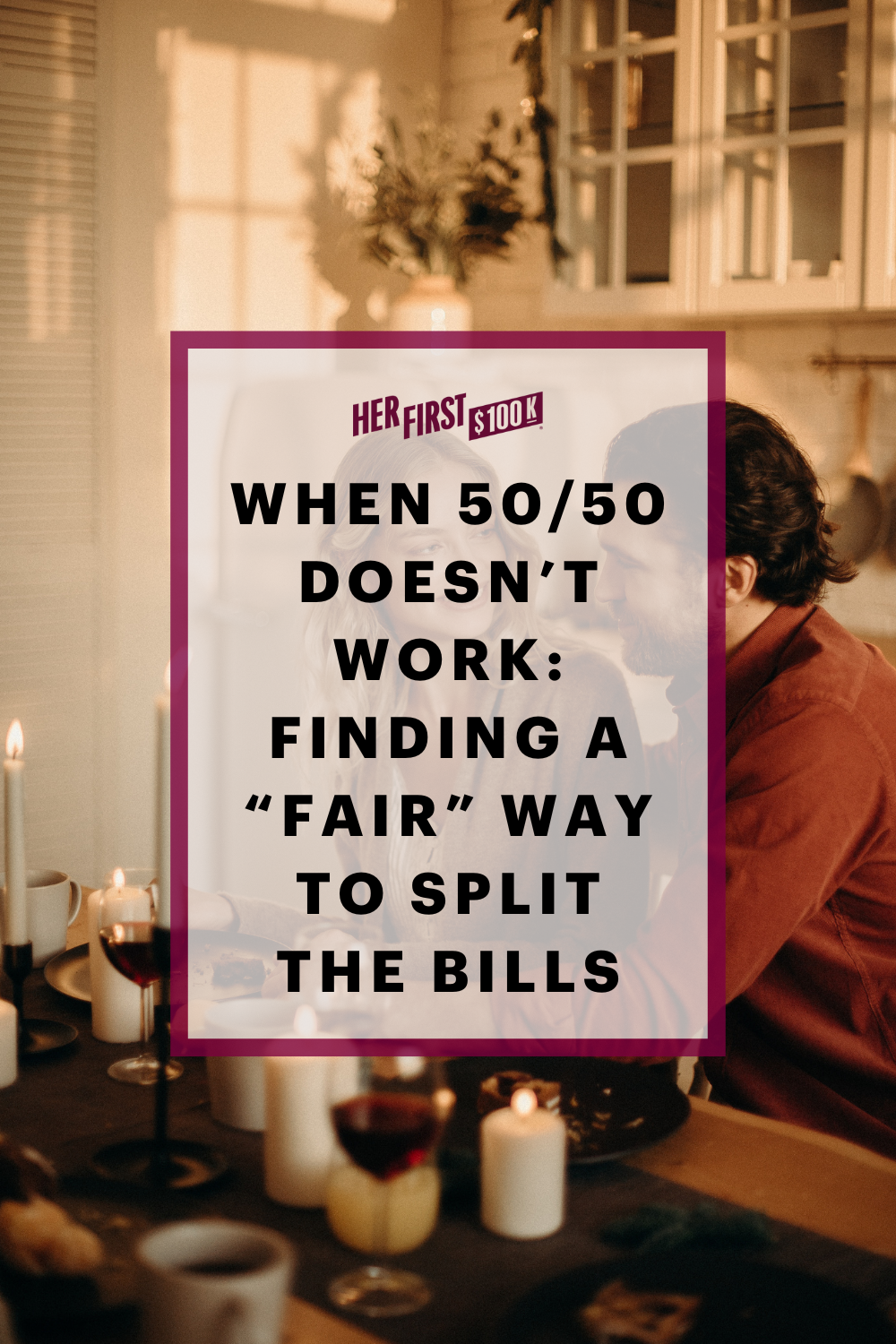The following article may contain affiliate links or sponsored content. This doesn’t cost you anything, and shopping or using our affiliate partners is a way to support our mission. I will never work with a brand or showcase a product that I don’t personally use or believe in.
How to handle money in relationships is one of the most complicated AND important financial conversations you’ll ever have with your partner. And one of the more tricky subjects is how to split expenses—especially if one partner earns more than the other.
I’m a self-made millionaire, and my boyfriend makes $60,000. We don’t split expenses equally—50-50—because it’s not equitable. Instead, we split things roughly 70-30, which is a more equitable balance for us.
We’ve had tons of conversations about money—we talked about it on the first date! I know how much he has in his Roth IRA, and he knows my brokerage account balance. I’m a huge fan of transparency in relationships when it comes to money. I think we should all be having money dates regularly, especially if you share accounts.
But how did we navigate the murky waters of figuring out what’s equitable? Let me walk you through it.
How to figure out what your split should be
Every relationship is unique, so it makes sense that we all handle money differently in our partnerships. But since every relationship spends money, having a plan is super important. No one wants to bicker about who picks up the bill on date night!
Step 1: Determine what’s individual spending vs joint spending
This will be different for every relationship, and is likely to change throughout the course of your time together, too. For example, if you’re still solidly in the dating phase, the category of “joint spending” might only apply to dinners out together or the occasional show.
Now, I’m not here to offer up unsolicited dating advice around who should or shouldn’t pick up the bill, but I am here to tell you that it’s worth having a conversation early on about how you like to spend your money. It doesn’t have to be on the first date (not everyone is a finance nerd like me), but if you’re spending money together, it’s better to have those conversations earlier rather than later, especially if your new love interest is into eight-course meals when you’re more of a DoorDash girlie.
For folks who are in long-term relationships, the joint spending category might be more involved. If you’re living together, things like rent, groceries, utilities, and random shit for the house typically counts as “ours.”
No matter what your commitment level is in your relationship, start your list. Here’s an example:
Individual spending:
- Cell phone bill
- Gym membership
- Coffee dates with friends
- Clothes
- Haircuts
Joint spending:
- Rent
- Utilities
- Groceries
- Date nights
- Vet visits for your shared fur baby
Step 2: Review your income levels and joint spending costs
If you’re in a fairly new relationship, you might not want to broach this right away. For some couples, it takes a while to open up about income (cue the shame monster that tells us we earn too much or too little).
But when you’re past the trial period and solidly in relationship territory, this is an important conversation to make sure you’re splitting your joint expenses equitably.
One easy way to figure out your equitable split is to determine the difference between your salaries. For example, if you earn $100,000 per year and your partner earns $60,000 per year, here’s how to determine your share:
[Your salary] divided by [your salary + your partner’s salary] = [your percentage of joint expenses]
So:
$100,000 / $160,000 = 0.625 or 62.5%
That would mean that you would then pay roughly 60% of the joint expenses.
To figure out your exact share of your expenses, here’s what you do:
[Total cost of joint expenses] x [your percentage of joint expenses] = [your share of joint expenses]
Let’s play it out, using an example of $1,000 as your joint expenses and assuming you’re paying 60% of them.
$1,000 x 0.6 = $600
So, if you split your joint expenses equitably in the scenario above, you’d pay $600 of your joint expenses and your partner would pay $400.
You might be thinking, “cool Tori, but this feels super complicated!” Here are a few ways you can approach this logistically.
How to make the equitable split work
There’s no right or wrong way to split your expenses, but some ways are easier than others. It’s up to you how comfortable you are with each of the options I’m gonna lay out here.
Venmo like it’s your job
The first option is…Venmo. Or Zelle. Or PayPal (does anyone still use that?!). Or paper checks…for every single thing you consider a joint expense.
If you’re not sharing too many expenses, this might work fine for you! The occasional dinner out is easy to split like this. (BTW I’m a big fan of one person picking up the check at dinner UNLESS you’re doing an easy 50-50 split. Be nice to your servers. They work really fucking hard.)
To be fair, I know a lot of couples who swear by the Venmo game. Rent, groceries, bills—you can designate who “owns” which payment, and then the other partner can send over their share. BUT…this can get to be a headache kinda fast, especially if you’re not doing a 50-50 split. So that’s where the next option comes in handy…
Divide your bills intentionally
If you’re looking to be more equitable but are a bit more flexible with your divide, you might choose to cover different bills.
For example, I had a friend who covered rent while her partner paid for groceries and utilities. That felt right for them based on their expenses and the way they wanted to split things.
This method is less mathematically accurate, but often “feels” better for folks who don’t want Venmo to request $3.00 for a churro.
If neither of these feel right, then you might like the last option…
Open a joint checking account
This might feel like a big move if you’re a newer couple, but it’s really not a huge deal.
A joint account (I recommend a high-yield savings account) can be a really great way to, as a couple, cover your expenses without the constant dance of paying one another back every five minutes. AND it has the added bonus of seeing how you handle money together, which is a major learning curve for most relationships.
Here’s how it works.
First, figure out exactly how much your joint spending is by looking at the last three months of joint expenses together. Make a spreadsheet, start a note in your phone, or grab a pen and paper and just write that shit down. It’s going to be a little arduous, but you got this.
Once you get your figure, divide it by three and that’s your average joint spending amount. Let’s use the example above and say it’s roughly $1,000 per month of joint expenses.
After you’ve determined your equitable share, that’s how much you each put into the account each month. Using the example above, you’d deposit $600, and your partner would contribute $400.
Then, every time you spend money on a joint expense—rent, dinner out, vet appointments—you pay for it using that account.
**Important note: I NEVER recommend completely combining your finances—even if you’re married! There are just too many horror stories out there, and I want you to always maintain a degree of financial independence.**
I really like this method because it will give you a clearer picture of exactly how much you’re spending as a couple and if you need to adjust your estimated joint spending money.
You also get to keep a decent amount of autonomy using this method. Your joint expenses will be covered, so you get a clearer picture of what’s left over each month for your individual spending. AKA, you can go watch Dune 2 in the IMAX for the sixth time. Just me? Cool.
TL;DR
There are many ways to make a relationship financially equitable. The method you choose to make it work logistically doesn’t matter—what matters is that you’re talking about it and making a game plan.
Ready to feel financially whole?
For the first time EVER, I’m teaching ALL the strategies that have helped countless women save money, pay off debt, and grow their net worth (but really, feel happier, healthier, and more f*cking powerful).
In The $100K Club, you’ll get in-depth teaching from me, alongside every template I use to manage my own money, PLUS a community of champions to keep you accountable.



